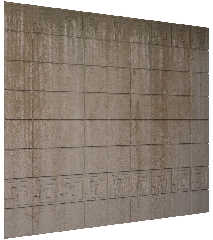 |
 |
|
 |
|
 |
|  |
|  |
|
 |
|
 |
|  |
|  |
|
 |
Hi,
although I'm not very new to povray (I already used it when it was
DKB-Trace), I'm very impressed by this draft made by a friend of mine in
Blender.
It's a kind of bathroom wall with tiles. Each tile in the top row and
the second row from bottom was made with a height field.
My question points to the dirt on the wall. It seems, like the dirt
drops down from above and fades out on its way down.
Can you tell me, how to do this in povray?
Thanks in advance
Ralf
Post a reply to this message
Attachments:
Download 'wall.jpg' (227 KB)
Preview of image 'wall.jpg'

|
 |
|  |
|  |
|
 |
|
 |
|  |
|  |
|
 |
On 25-9-2014 13:06, Ralf Jonas wrote:
> Hi,
>
> although I'm not very new to povray (I already used it when it was
> DKB-Trace), I'm very impressed by this draft made by a friend of mine in
> Blender.
> It's a kind of bathroom wall with tiles. Each tile in the top row and
> the second row from bottom was made with a height field.
> My question points to the dirt on the wall. It seems, like the dirt
> drops down from above and fades out on its way down.
> Can you tell me, how to do this in povray?
>
> Thanks in advance
> Ralf
>
The most simple setup would be with a layered texture. The underlying
one being the tiles; overlying that a simple texture with a gradient
pigment_map with a strong vertical turbulence would do the trick. The
most 'difficult' part would be to scale and translate that texture
correctly but knowing the dimensions of the wall would help. For instance:
texture {tile}
texture {
gradient y
pigment_map {
[0.2 a transparent pigment]
[0.6 a dirt pigment]
}
warp {turbulence <0, 0.6, 0>}
scale ....
translate ....
}
Thomas
Post a reply to this message
|
 |
|  |
|  |
|
 |
|
 |
|  |
|  |
|
 |
Thomas de Groot <tho### [at] degroot org> wrote:
> On 25-9-2014 13:06, Ralf Jonas wrote:
> > Hi,
> >
> > although I'm not very new to povray (I already used it when it was
> > DKB-Trace), I'm very impressed by this draft made by a friend of mine in
> > Blender.
> > It's a kind of bathroom wall with tiles. Each tile in the top row and
> > the second row from bottom was made with a height field.
> > My question points to the dirt on the wall. It seems, like the dirt
> > drops down from above and fades out on its way down.
> > Can you tell me, how to do this in povray?
> >
> > Thanks in advance
> > Ralf
> >
> The most simple setup would be with a layered texture. The underlying
> one being the tiles; overlying that a simple texture with a gradient
> pigment_map with a strong vertical turbulence would do the trick. The
> most 'difficult' part would be to scale and translate that texture
> correctly but knowing the dimensions of the wall would help. For instance:
>
> texture {tile}
> texture {
> gradient y
> pigment_map {
> [0.2 a transparent pigment]
> [0.6 a dirt pigment]
> }
> warp {turbulence <0, 0.6, 0>}
> scale ....
> translate ....
> }
>
> Thomas
The easier way is to just UV map it and export to Povray. Dirt isn't all that
difficult to make in GIMP. org> wrote:
> On 25-9-2014 13:06, Ralf Jonas wrote:
> > Hi,
> >
> > although I'm not very new to povray (I already used it when it was
> > DKB-Trace), I'm very impressed by this draft made by a friend of mine in
> > Blender.
> > It's a kind of bathroom wall with tiles. Each tile in the top row and
> > the second row from bottom was made with a height field.
> > My question points to the dirt on the wall. It seems, like the dirt
> > drops down from above and fades out on its way down.
> > Can you tell me, how to do this in povray?
> >
> > Thanks in advance
> > Ralf
> >
> The most simple setup would be with a layered texture. The underlying
> one being the tiles; overlying that a simple texture with a gradient
> pigment_map with a strong vertical turbulence would do the trick. The
> most 'difficult' part would be to scale and translate that texture
> correctly but knowing the dimensions of the wall would help. For instance:
>
> texture {tile}
> texture {
> gradient y
> pigment_map {
> [0.2 a transparent pigment]
> [0.6 a dirt pigment]
> }
> warp {turbulence <0, 0.6, 0>}
> scale ....
> translate ....
> }
>
> Thomas
The easier way is to just UV map it and export to Povray. Dirt isn't all that
difficult to make in GIMP.
Post a reply to this message
|
 |
|  |
|  |
|
 |
|
 |
|  |
|  |
|
 |
On 25-9-2014 18:04, jhu wrote:
> The easier way is to just UV map it and export to Povray. Dirt isn't all that
> difficult to make in GIMP.
That is cheating :-)
Thomas
Post a reply to this message
|
 |
|  |
|  |
|
 |
|
 |
|  |




![]()